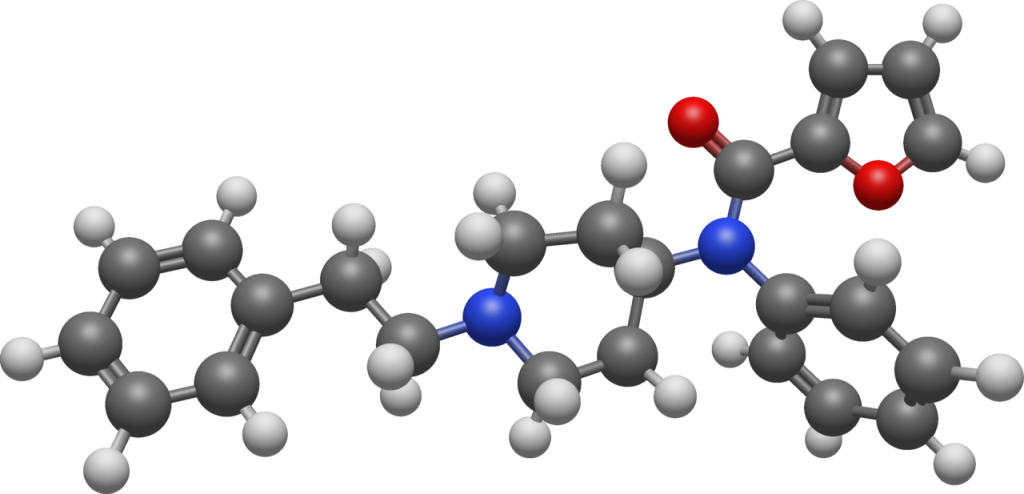Summary
Furanylfentanyl (Fu-F) is an opioid analgesic, structurally similar to fentanyl, and has been distributed as a designer drug.[2][3] In mice, it exhibits an ED50 value of 0.02 mg/kg, indicating it is roughly one-fifth as potent as fentanyl.
| Identifiers | |
|---|---|
| IUPAC name | |
| CAS Number | 101345-66-8 |
|---|---|
| PubChem CID | 13653606 |
| ChemSpider | 14921702 |
| UNII | 3F7C9J1LS7 |
| Chemical and physical data | |
| Formula | C24H26N2O2 |
| Molar mass | 374.484 g·mol−1 |

Side effects
The side effects associated with fentanyl analogs closely resemble those of fentanyl itself. These effects encompass itching, nausea, and potentially severe respiratory depression, which can pose life-threatening risks. The resurgence in the use of fentanyl analogs in Estonia in the early 2000s initiated a wave of fatalities, with hundreds of deaths reported across Europe and the former Soviet republics. Furthermore, new derivatives of these analogs continue to emerge.
Instances of life-threatening adverse reactions linked to furanyl fentanyl usage have been documented in Sweden and Canada. In Cook County, Illinois, at least seven fatalities in 2016 were attributed to furanyl fentanyl, with additional deaths occurring in suburban Chicago in 2017.
To detect furanyl fentanyl in biological fluids, such as blood or urine, for monitoring usage, confirming poisoning diagnoses, or aiding in medicolegal death investigations, various methods are employed. Initial screening typically relies on commercially available immunoassays. However, confirmation and quantification are predominantly carried out using chromatographic techniques. In cases of fatal overdose, blood furanyl fentanyl concentrations are typically found within the range of 1-45 μg/L.

Legal status
As of January 2016, Sweden has prohibited the use of furanylfentanyl[15].
In the United States, the Drug Enforcement Administration (DEA) took steps to categorize furanylfentanyl as a Schedule I substance under the Controlled Substances Act. The proposal for this temporary placement was made on September 27, 2016. Subsequently, on November 29, 2016, the DEA finalized its rule, officially classifying furanyl fentanyl as a Schedule I controlled substance.
FAQ
- What is Furanylfentanyl?
- Furanylfentanyl is an opioid analgesic that is chemically similar to fentanyl and is often used as a designer drug.
- How potent is Furanylfentanyl compared to fentanyl?
- Furanylfentanyl is approximately one-fifth as potent as fentanyl, with an ED50 value of 0.02 mg/kg in mice.
- What are the side effects of Furanylfentanyl?
- Side effects of Furanylfentanyl are similar to those of fentanyl and may include itching, nausea, and potentially life-threatening respiratory depression.
- Has Furanylfentanyl caused fatalities?
- Yes, Furanylfentanyl and similar fentanyl analogs have been linked to numerous deaths, particularly in Europe and the former Soviet republics. These substances can be extremely dangerous.
- Is Furanylfentanyl illegal?
- Furanylfentanyl is illegal in several countries, including Sweden and the United States, where it is classified as a Schedule I controlled substance.
- How is Furanylfentanyl detected in biological fluids?
- Furanylfentanyl can be detected in blood or urine using various testing methods. Initial screening tests often use immunoassays, while confirmation and quantification typically rely on chromatographic techniques.
- Is Furanylfentanyl still available on the black market?
- While regulatory agencies have taken steps to control Furanylfentanyl, illegal markets may still distribute it, posing significant risks to users.
- What should I do if I suspect someone has used Furanylfentanyl?
- If you suspect someone has used Furanylfentanyl and is experiencing adverse effects, seek immediate medical attention. Overdoses can be life-threatening and require prompt medical intervention.
- Can doctors prescribe Furanylfentanyl?
- No, Furanylfentanyl is not approved for medical use and is not prescribed by healthcare professionals.
- Where can I find more information about the legal status of Furanylfentanyl in my country?
- To find information about the legal status of Furanylfentanyl in your country, you should refer to your country’s drug regulatory agency or law enforcement authorities.
References
- Bagley JR, Wynn RL, Rudo FG, Doorley BM, Spencer HK, Spaulding T (March 1989). “New 4-(heteroanilido)piperidines, structurally related to the pure opioid agonist fentanyl, with agonist and/or antagonist properties”. Journal of Medicinal Chemistry. 32 (3): 663–671. This study explored compounds related to fentanyl with both agonist and antagonist properties.
- Kanamori T, Okada Y, Segawa H, Yamamuro T, Kuwayama K, Tsujikawa K, Togawa-Iwata Y (August 2020). “Detection and confirmation of the ring-opened carboxylic acid metabolite of a new synthetic opioid furanylfentanyl”. Forensic Toxicology. 39: 114–122. This research focused on detecting a metabolite of furanylfentanyl in forensic toxicology.
- Bilel S, Azevedo Neto J, Arfè R, Tirri M, Gaudio RM, Fantinati A, et al. (May 2022). “In vitro and in vivo pharmaco-dynamic study of the novel fentanyl derivatives: Acrylfentanyl, Ocfentanyl and Furanylfentanyl”. Neuropharmacology. 209: 109020. This study investigated the pharmacodynamics of fentanyl derivatives, including furanylfentanyl.
- Huang BS, Terrell RC, Deutsche KH, Kudzma LV, Lalinde NL (9 April 1984). “Patent US4584303 – N-aryl-N-(4-piperidinyl)amides and pharmaceutical compositions and method employing such compounds”. This patent discusses pharmaceutical compounds related to N-aryl-N-(4-piperidinyl)amides.
- Chen Q, Shang Y, Xu Y, Li P, Li P, Liu GL (February 2016). “Analgesic effect and pharmacological mechanism of fentanyl and butorphanol in a rat model of incisional pain”. Journal of Clinical Anesthesia. 28: 67–73. This research explored the analgesic effects and mechanisms of fentanyl and butorphanol in a rat model.
- Mounteney J, Giraudon I, Denissov G, Griffiths P (July 2015). “Fentanyls: Are we missing the signs? Highly potent and on the rise in Europe”. The International Journal on Drug Policy. 26 (7): 626–631. This article discusses the increasing presence of highly potent fentanyl derivatives, including their rise in Europe.
- Helander A, Bäckberg M, Beck O (20 April 2016). “Intoxications involving the fentanyl analogs acetylfentanyl, 4-methoxybutyrfentanyl and furanylfentanyl: results from the Swedish STRIDA project”. Clinical Toxicology. 54 (4): 324–332. This study reports on intoxications involving fentanyl analogs in Sweden.
- Klar SA, Brodkin E, Gibson E, Padhi S, Predy C, Green C, Lee V (September 2016). “Notes from the Field: Furanyl-Fentanyl Overdose Events Caused by Smoking Contaminated Crack Cocaine – British Columbia, Canada, July 15-18, 2016”. MMWR. Morbidity and Mortality Weekly Report. 65 (37): 1015–1016. This report highlights overdose events related to furanyl-fentanyl in Canada.
- Preckwinkle T (18 April 2016). “Medical Examiner Reports Deaths from Powerful Opioids on the Rise”. Cook County Government. This government report discusses the rising deaths related to powerful opioids, including furanyl-fentanyl, in Cook County.
- Mohr AL, Friscia M, Papsun D, Kacinko SL, Buzby D, Logan BK (November 2016). “Analysis of Novel Synthetic Opioids U-47700, U-50488 and Furanyl Fentanyl by LC-MS/MS in Postmortem Casework”. Journal of Analytical Toxicology. 40 (9): 709–717. This research analyzes synthetic opioids, including furanyl fentanyl, in postmortem cases.
- Marrazzo A. “New form of synthetic heroin showing up in Chicago-area deaths”. McHenry County. Retrieved 2017-02-04. This news report discusses the appearance of synthetic heroin, including its presence in Chicago-area deaths.
- Baselt, R. (2017) Disposition of Toxic Drugs and Chemicals in Man, 11th edition, Biomedical Publications, Foster City, CA, p. 2315. This reference book provides information on the disposition of toxic drugs and chemicals in humans.
- Dybowski MP, Dawidowicz AL (January 2020). “Furanylfentanyl in whole blood measured by GC–MS/TS after QuEChERS extraction in a fatal case”. Forensic Toxicology. 38 (2): 496–504. This study measures furanylfentanyl in whole blood in a fatal case.
- “31 nya ämnen kan klassas som narkotika eller hälsofarlig vara” (in Swedish). Folkhälsomyndigheten. 17 November 2015. This report (in Swedish) discusses substances that can be classified as narcotics or health-hazardous products.
- Drug Enforcement Administration (DEA) (27 September 2016). “Proposed Rule: Schedules of Controlled Substances: Temporary Placement of Furanyl Fentanyl Into Schedule I”. Federal Register. This proposed rule by the DEA focuses on the temporary placement of furanyl fentanyl into Schedule I of controlled substances.
- “2016 – Final Order: Temporary Placement of Furanyl Fentanyl Into Schedule I”. www.deadiversion.usdoj.gov. This document outlines the final order for the temporary placement of furanyl fentanyl into Schedule I.